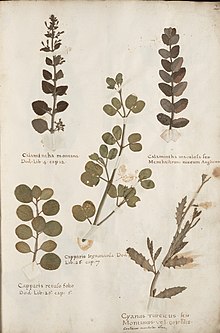
A herbarium (plural: herbaria) is a collection of preserved plant specimens and associated data used for scientific study.[2]
The specimens may be whole plants or plant parts; these will usually be in dried form mounted on a sheet of paper (called exsiccatum, plur. exsiccata) but, depending upon the material, may also be stored in boxes or kept in alcohol or other preservative.[3] The specimens in a herbarium are often used as reference material in describing plant taxa; some specimens may be types, some may be specimens distributed in series called exsiccatae.
The same term is often used in mycology to describe an equivalent collection of preserved fungi, otherwise known as a fungarium.[4] A xylarium is a herbarium specialising in specimens of wood.[5] The term hortorium (as in the Liberty Hyde Bailey Hortorium) has occasionally been applied to a herbarium specialising in preserving material of horticultural origin.[6]
- ^ "Herbarius continens species plantarum tum patriarum tum exoticarum ad vivum prout nascuntur in horto infirmariae celeberrimae Abbatiae Diligemensis". lib.ugent.be. Retrieved 2020-08-27.
- ^ Edinburgh, Royal Botanic Garden. "Royal Botanic Garden Edinburgh - What is a herbarium". www.rbge.org.uk. Archived from the original on 2016-03-06. Retrieved 2016-03-25.
- ^ "Preparing and Storing Herbarium Specimens" (PDF). Conserve O Gram. National Park Service. November 2009. Retrieved 24 March 2016.
- ^ "Fungarium". www.kew.org. Royal Botanic Gardens, Kew. Retrieved 2 February 2016.
- ^ "Wood collection (xylarium)". www.kew.org. Royal Botanic Gardens, Kew. Archived from the original on 17 July 2016. Retrieved 2 February 2016.
- ^ "Liberty Hyde Bailey Hortorium". plantbio.cals.cornell.edu. Cornell University College of Agriculture and Life Sciences. Retrieved 2 February 2016.